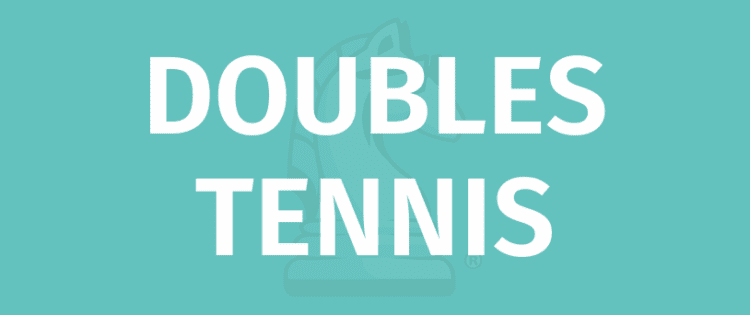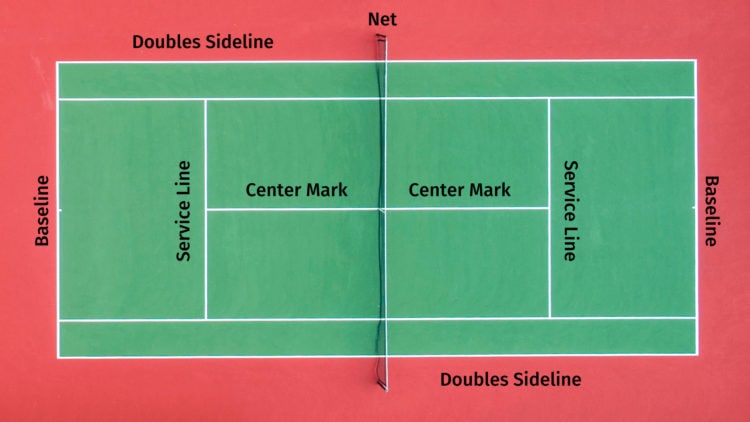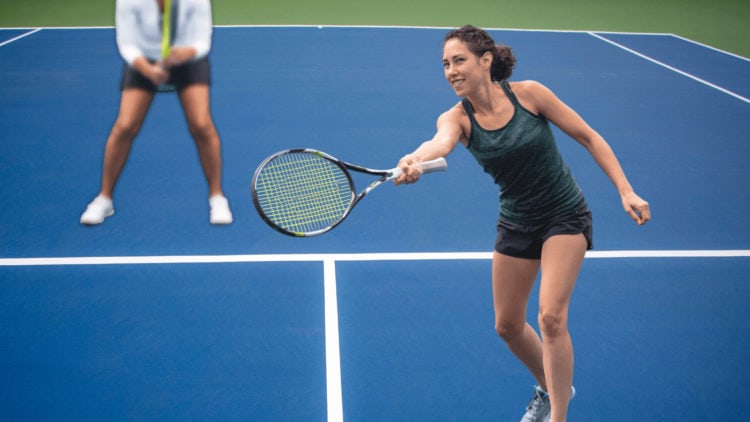
OBJECTIVE OF DOUBLES TENNIS: Get points by hitting the ball to the opposing team’s side of the court so that they are unable to return the ball.
NUMBER OF PLAYERS: 4 players, 2 on each team
MATERIALS: 1 tennis racket per player, 1 tennis ball
TYPE OF GAME: Sport
AUDIENCE: 5+
OVERVIEW OF DOUBLES TENNIS
Tennis is a racket sport where two players hit a ball back and forth across a court. In doubles tennis, there are two players on each team working together. Although tennis is usually played as an individual sport, the interest in doubles tennis has increased in recent years. To learn more about the rules for singles tennis, check out our article on the topic!
SETUP

A tennis court is a rectangular court with a low net that stretches in the center across the width to divide the court into two. Tennis courts should be 78 feet long with a width of 36 feet for doubles matches.
The service lines are centered horizontally on the two sides of the court, and the baseline should run horizontally along the width of the tennis court at the very ends. The lines that run down vertically are called sidelines. There will typically be two sidelines to mark the limits for doubles matches. And finally, the center mark is a line that goes down the center of the court.
Tennis can be played on a variety of different flooring surfaces. The four main types are grass courts, clay courts, hard courts, and carpet courts. Tennis can also be played indoors.
GAMEPLAY

A tennis match always starts with a coin toss. The team that wins the coin toss has the option to:
- Serve first
- Receive first
- Choose which side to start on
If the team that wins the coin toss decides to serve, the losing team can decide which side of the court they want to start the match.
SERVING
Each team has a first server and a second server. The first server will serve for an entire game and then allow the first server from the other team to serve. Then, the second server from the first team will serve. And so on.
The non-serving player on a team can stand anywhere during the serve.
The server stands between the sideline and the center line and stands behind the baseline. Players are required to serve diagonally, so the server can choose whether to serve diagonally on the right or left side of the tennis court.
Once in position, the server serves a ball. For it to be considered a “legal serve,” the server must:
- Throw the ball in the air
- Hit the ball with the racket
- Hit the ball before it hits the ground
- Hit the ball diagonally across the court
- Hit the ball so that it lands within the serving line of the receiver’s side of the court
After each point is awarded, the server must also alternate between the two vertical halves of the court.
FAULT
There are two types of faults in tennis: service faults and foot faults.
- A service fault happens when the ball’s first bounce occurs outside the serving area.
- A foot fault occurs when a player steps on or outside the baseline or the sideline while serving.
After two faults in a row, the receiving team is automatically awarded a point.
LET
During a serve, if the ball hits the net but is otherwise still a legal serve, the server gets another two chances to serve. In other words, if a “let” is called, the server still gets two tries to hit a valid serve.
RECEIVING
Each player on the receiving team must stand on their designated side of the court. The server will serve from one side of the court diagonally to a designated receiver. This player must initially return the ball. After the initial return, the players can then hit the ball from any part of the court.
Just as the servers will alternate on a team, so will the receivers. So during game 1 of a set, player A will receive the ball, and during game 3, player B will receive the ball. The other player on the receiving team must stand on the opposite half of the receiving court.
RALLYING
Once a ball is successfully served, the ball will be in play, also called a rally. The two teams will alternate hitting the ball across the court until a point is scored. Either player on a team can hit the ball back from any area on the court. The players do not need to alternate hitting the ball.
To properly return a serve, the receiving team must hit the ball before the ball bounces twice on their side of the court. The rally continues until a point is scored.
VOLLEYS
In tennis, you can volley the ball, where you hit the ball before it touches your end of the court.
SCORING
Tennis is played in points. The point sequence is as follows:
0 point = love
1 point = 15
2 points = 30
3 points = 40
4 points = game
To win a game, a team must win by at least two points. So, if the two teams are at 40-40, a “deuce” is called. The winner of the next point is awarded an “advantage” at which point the team can win the game by taking the second point. However, if the next point brings the score back to a deuce, the game will continue until a team eventually wins the game by two points.
Here are the ways to gain points in tennis:
- The opposing team is unable to hit back a valid shot.
- The ball bounces twice on the opposing team’s side of the court.
- The opposing team hits the net with the ball.
- The opposing team hits a shot outside of court boundaries.
- The opposing team serves a double fault.
END OF GAME
A tennis match is made up of points, games, and sets: 4 points with at least a 2-game advantage to win a game, 6 games with a margin of at least two games to win a set, and 2 or 3 sets to win a match. Most tennis matches will be played as a best of 3 or 5 sets.
- Comprehensive Guide to the Board Game Go (weiqi, baduk) - January 23, 2024
- Are Creative Suites Changing Gaming - October 30, 2023
- Crowning the Kings of Solitaire: GameRules Recognizes Solitaired and MobilityWare as top Solitaire Games - October 20, 2023